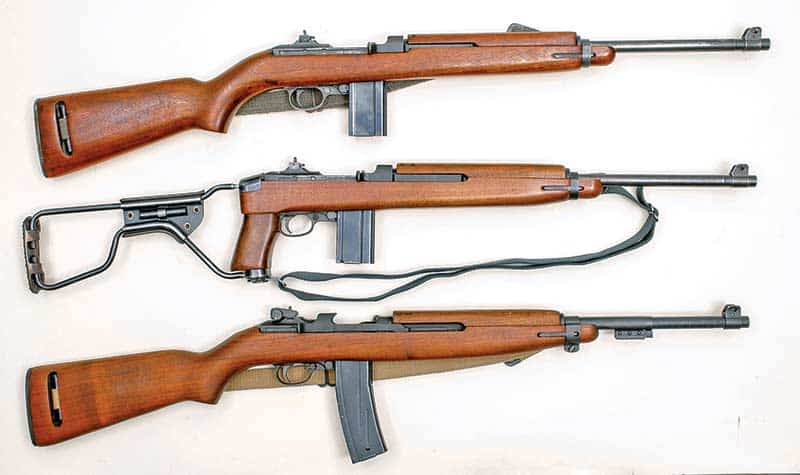The M2 Carbine
Full-auto “Light Rifle” is a hoot to shoot
One of World War II’s most successful infantry weapons was the U.S. Carbine Caliber .30. It was manufactured by no fewer than 10 factories to the tune of over six million in only about four years. When the U.S. Government decided they needed a “light rifle” to replace .45 Auto Model 1911A1s, their original specs called for select-fire capability — semi-auto or full-auto — at the push of a button or lever. It didn’t happen. During testing of initial prototypes in May 1941, full-auto reliability was spotty.
Thereafter the select-fire stipulation was dropped because the new weapon was needed quickly. (The “light rifle” moniker was also shed along the way.) Eventually, in further testing later in 1941, Winchester’s prototype won, became the legendary M1 .30 Carbine and served U.S. forces around the world until well into the 1960s.
Forgetting The Blaster
However, the selection fire option had not been forgotten. By 1944 reports from battlefields indicated full-auto .30 Carbines would have been an asset. The idea was the carbine should be accurate to 300 yards with aimed, semi-auto fire, with full-auto coming into play in short-range “emergency” situations. Those Japanese “Banzai charges” come to mind.
First needed were magazines with higher capacity. Obviously 15-rounders as standard with semi-auto M1 .30 Carbines were too limited for a full-auto. Thus a 30-round curved one was developed even before full-auto designs have been accepted. By July, 1944, Inland Manufacturing — the largest producer of M1 .30 Carbines — had developed an experimental full-auto designated T4.
Here’s something I did not know, even having been a M1 .30 Carbine fan for over 50 years — 500 T4 “experimental” .30 Carbines were produced along with 8,500 curved 30-round magazines and sent to various military bases for testing. Some were sent to the Pacific Theater of Operations for combat use. By September 1944, the government accepted the Inland modification as the “U.S. Carbine Caliber .30 M2.” Semi-auto .30 Carbines were then classified as Limited Standard.
Building And Rebuild
Only Winchester and Inland were contracted to produce the new M2. Production of the new full-auto version began in the spring of 1945. Since Germany surrendered in May 1945 and Japan followed in August, it’s doubtful if any M2s built from scratch saw combat during the war.
Post-war M1 .30 Carbines were called in for refurbishing. Bayonet lugs were installed, non-adjustable aperture rear sights were replaced with fully-adjustable types and many thousands were converted to M2. Most, but not every one, of the conversions received a “2” over-stamp on the M1.
High Point
It was in the Korean War of 1950 to 1953 when M2 .30 Carbines saw their heyday. They were widely issued to Army and Marine Corps troops. There were reports of poor performance at times due to a lack of stopping power (.30 Carbine is a 110-gr. FMJ at 2,000 fps) but there were also reports of their effectiveness during “human wave” attacks by Chinese “volunteers.” Both M1 and M2 .30 Carbines were also used extensively in the Vietnam War by both sides.
Tank Has His Fun
Personally speaking, my very first centerfire firearm was an M1 .30 Carbine as sold by the Director of Civilian Marksmanship (DCM) to NRA members. I was 16 and my father purchased one for me. Many .30 Carbines, including some handguns, have passed through my hands over the years but it was not until 2008 that I endured the ATF’s red tape and several months’ wait to take delivery of an M2 .30 Carbine. Actually, it was an over-stamped M1 produced by the Saginaw Steering Gear Corporation during World War II. Converting an M1 to M2 required special parts and a heavier stock was designed with a recess cut into the left side for the select-fire lever.
My M2 is a hoot to shoot. While not a tack-driver in semi-auto, it’s perfectly adequate for its intended combat purpose. Then, with a simple flick of the thumb, it becomes a machine gun! And it’s no “chug-master” like the M3 .45 auto submachine gun — aka “grease gun.” M2 .30 Carbines’ full-auto RPM (rounds per minute) are rated at a fast 750 to 800. It will empty a 15-round magazine in a couple seconds. Like many before me I’ve found the curved 30-round mags to be less reliable than the straight 15-round types. Although not considered a submachine gun per se, it’s one in practical fact and perhaps one of the best ever.






